Pollinator habitat gardens are often bursting with colorful and fragrant annual and perennial plants that are known to attract bees, butterflies, and other beneficial insects. But if you keep a pollinator garden, you may want to try out different types of plants to create a more complex garden design that will draw the eye (and pollinators, too) into your landscape. If you happen to have a garden archway, pergola, trellis, or front porch banister that needs some sprucing up, growing a few climbing plants for pollinators can be a great idea!
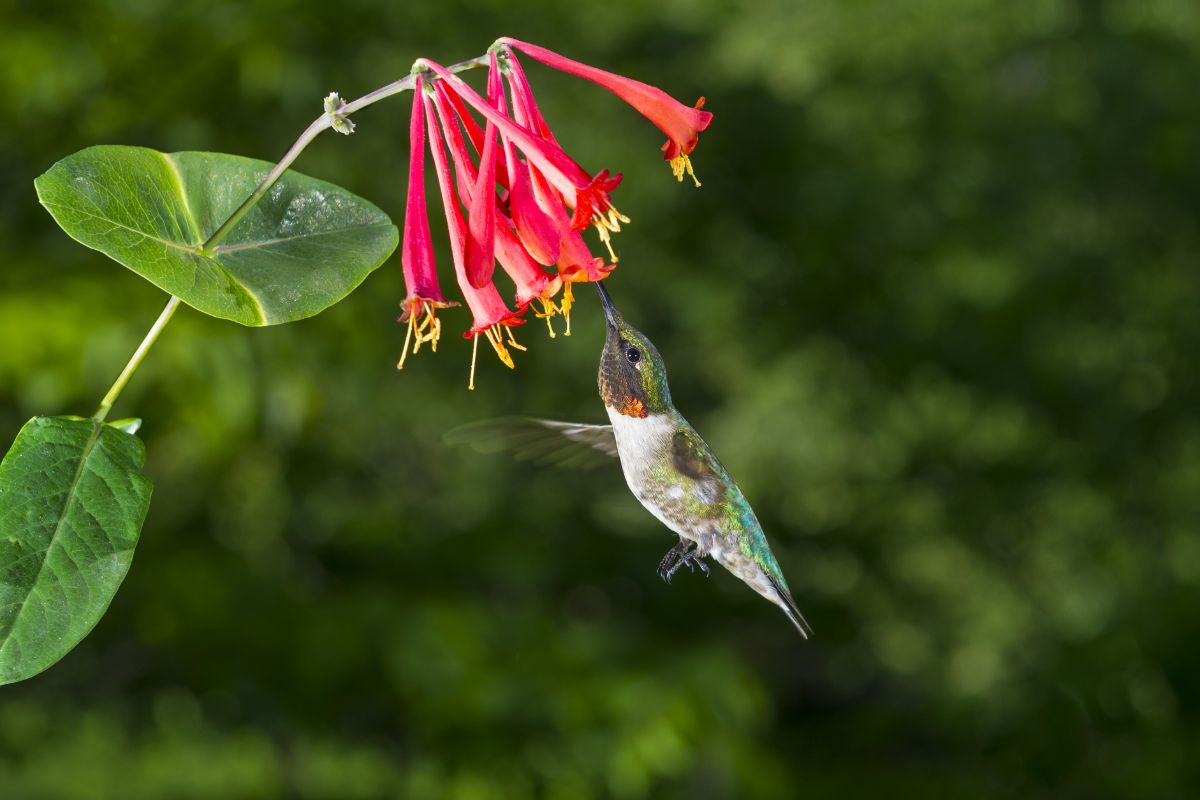
In this guide, you’ll discover the best climbing plants to grow in a pollinator garden. These plants are rich in nectar and pollen for insects, but they also have a visual appeal that will delight garden visitors too. From honeysuckle to jasmine, there are tons of spectacular pollinator vines that we think you’ll adore.
Jump to:
- Note on selecting climbing vines for pollinators
- 18 best climbing plants to grow in a pollinator garden
- 1. Coral honeysuckle (Lonicera sempervirens)
- 2. Trumpet vine (Campsis radicans)
- 3. Moonflower (Ipomoea alba)
- 4. Star jasmine (Trachelospermum jasminoides)
- 5. Clematis (Clematis spp.)
- 6. Chocolate vine (Akebia quinata)
- 7. Climbing hydrangea (Hydrangea anomala)
- 8. Sweet peas (Lathyrus odoratus)
- 9. Virginia creeper (Parthenocissus quinquefolia)
- 10. American wisteria (Wisteria frutescens)
- 11. Scarlet runner beans (Phaseolus coccineus)
- 12. Passionflower (Passiflora incarnata)
- 13. Butterfly vine (Mascagnia macroptera)
- 14. Bougainvillea (Bougainvillea spp.)
- 15. Squash, melons, and cucumbers (Cucurbita spp.)
- 16. Grapes (Vitis spp.)
- 17. Crossvine (Bignonia capreolata)
- 18. Dutchman’s Pipe (Aristolochiamacrophylla)
- Summary
Note on selecting climbing vines for pollinators
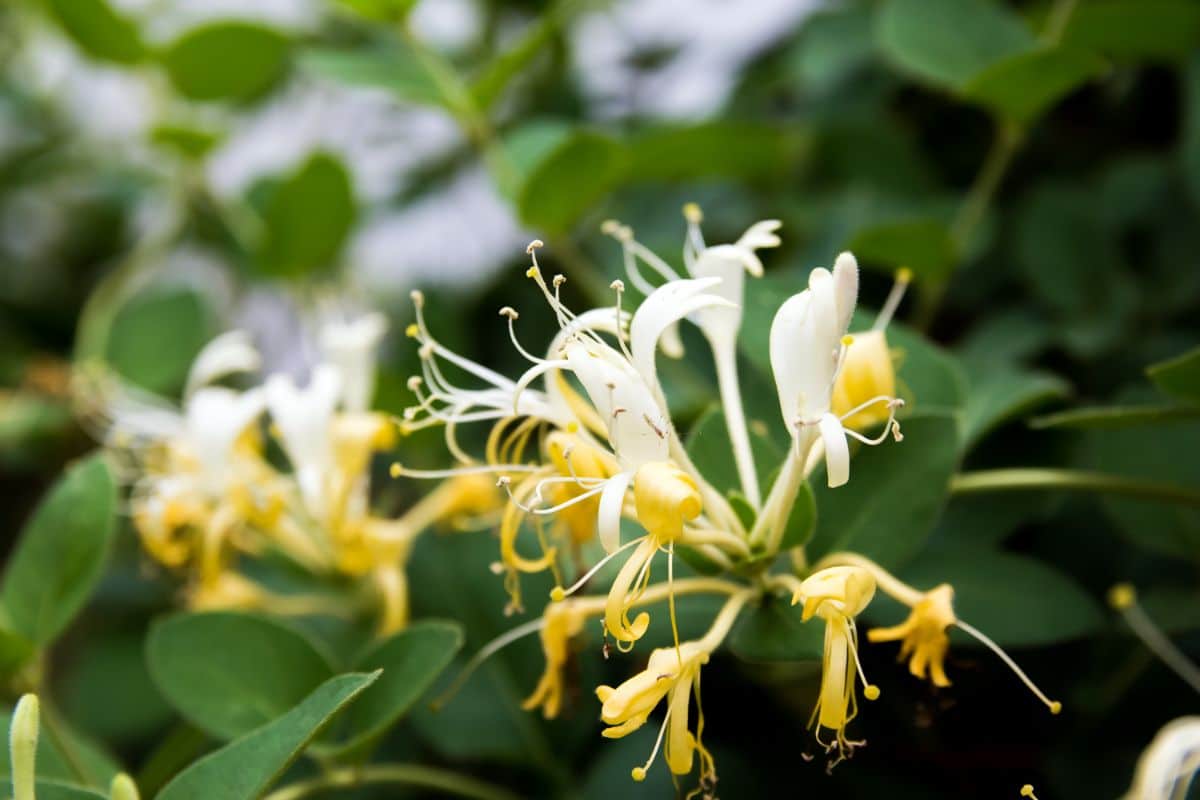
While there are a lot of gorgeous ornamental vines at plant nurseries that will attract pollinators, one thing to keep in mind is that some vining plants can be potentially invasive. Japanese honeysuckle (Lonicera japonica), for example, is a known invasive that’s currently still sold at many plant nurseries. And while this plant can attract pollinators, it’s best to avoid it as it can be very destructive to the landscape.
Some of the plants in the list below may be considered invasive in some areas, so it’s important to do your research to determine if they’re appropriate for your growing zone and garden.
18 best climbing plants to grow in a pollinator garden
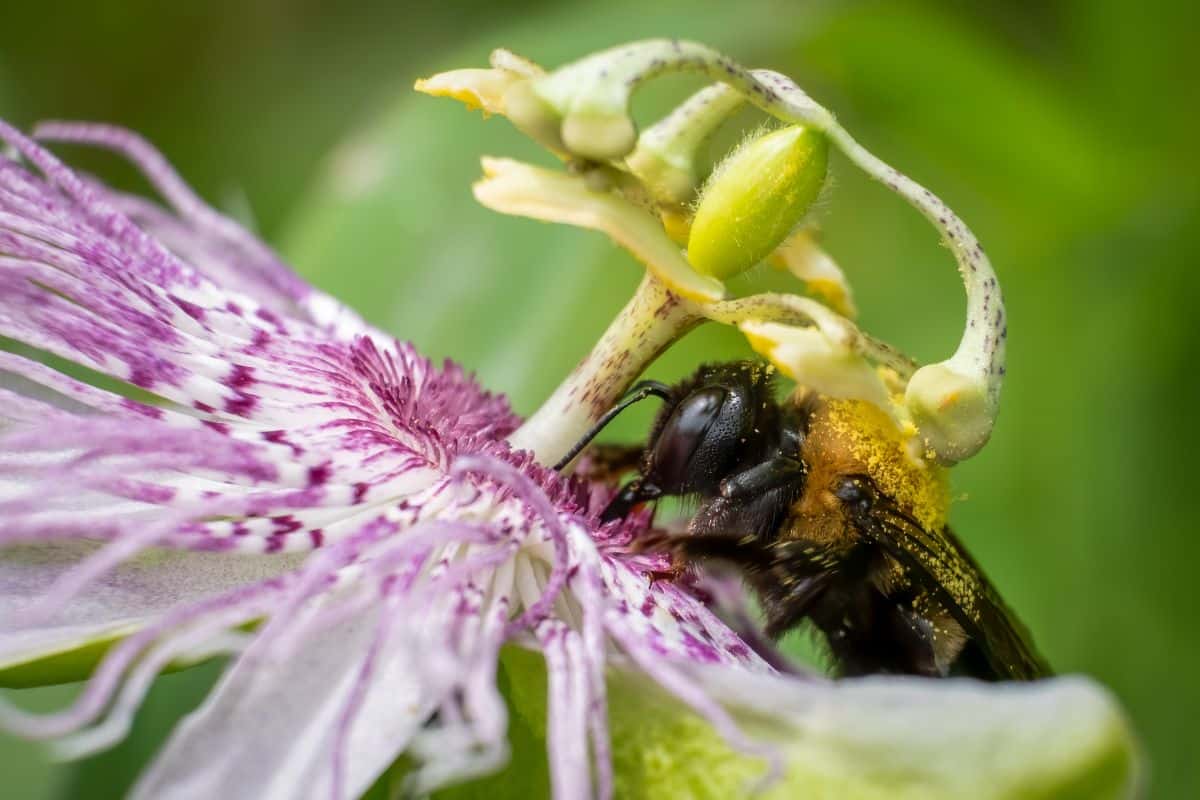
Shorter perennial and annual plants often make up the bulk of garden plantings in pollinator gardens. But if you want to squeeze even more plants into your landscape, make smart use of vertical space by growing climbing vines. When they flower, vining plants for pollinators will add brilliant color to porch railings and fencing, and they’ll provide an important food source for bees, butterflies, and hummingbirds too!
1. Coral honeysuckle (Lonicera sempervirens)
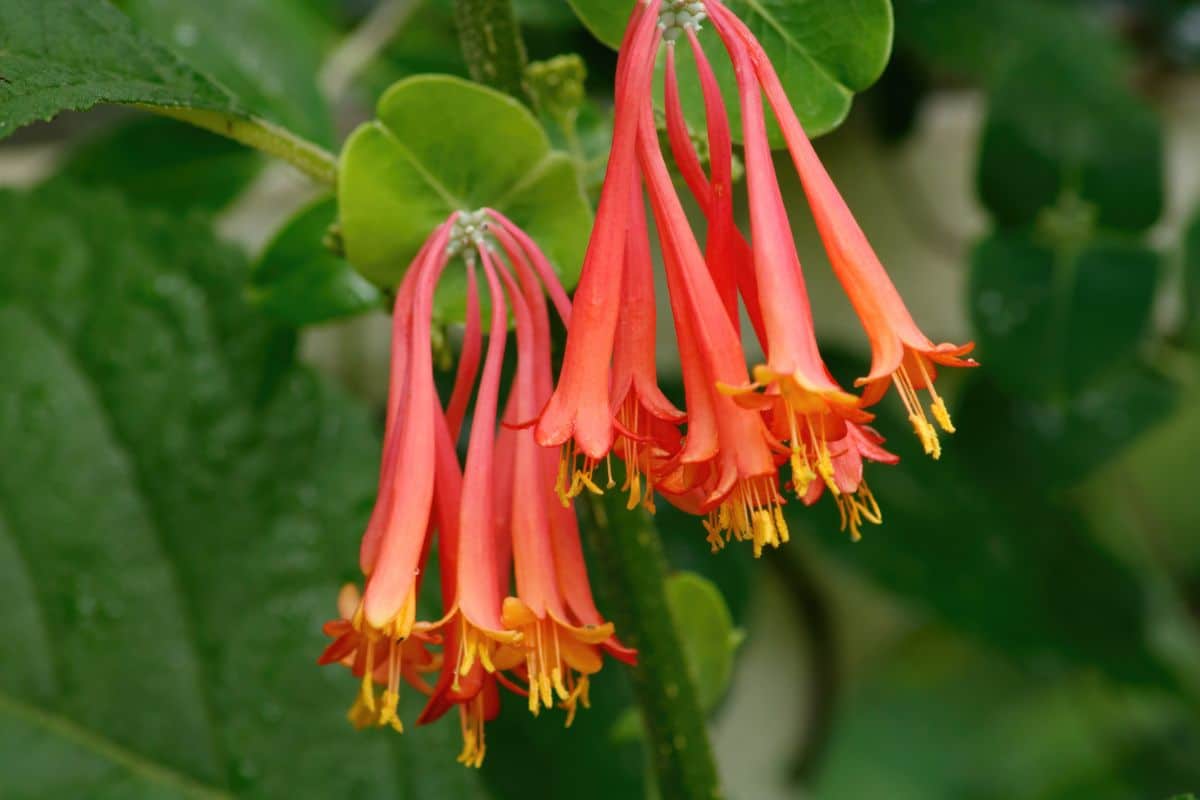
| Plant name: | Coral honeysuckle |
| Light requirements: | Full sun |
| Water requirements: | Moderate |
| Growing zone: | Zones 4 to 10 |
| Bloom time: | Late spring to early summer, as well as sporadic blooms throughout the season |
Honeysuckle is a diverse group of plants with both deciduous and evergreen varieties. Some honeysuckles grow in a bush-like form; however, if you’re looking for a vining plant to attract pollinators, some honeysuckle varieties vine as well. Just be sure to locate a native honeysuckle variety, as non-native honeysuckles, like Japanese honeysuckle, can quickly become invasive in many areas.
If you live in North America, one of the best native honeysuckle vine options is the coral or trumpet honeysuckle. This plant has long, tubular flowers that are a bright, pinkish-red color that’s sure to lure hummingbirds and other pollinators to your yard. While the flowers are fragrance-free, their bright coloration will make them the highlight of pergolas, trellises, and more, but you may want to add a galvanized tension wire to your plant’s support because trumpet honeysuckles can get heavy!
2. Trumpet vine (Campsis radicans)
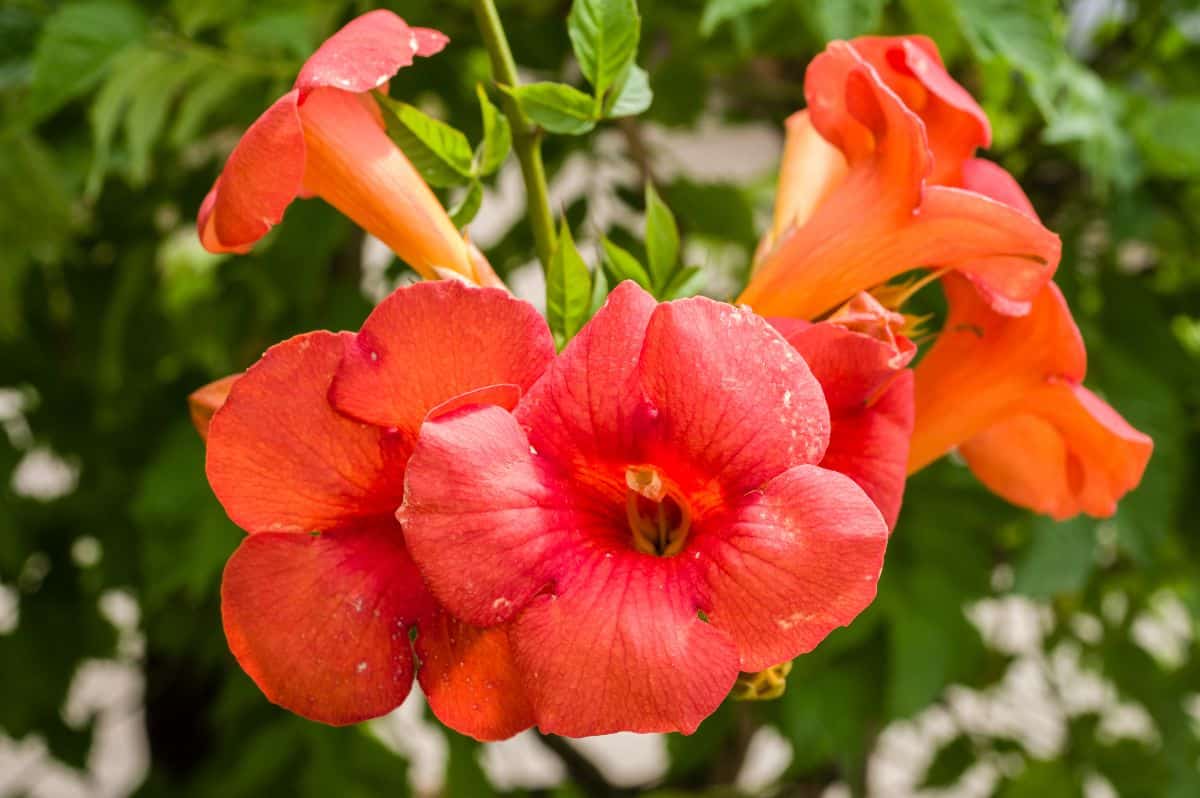
| Plant name: | Trumpet vine |
| Light requirements: | Full sun to part shade |
| Water requirements: | Moderate |
| Growing zone: | Moderate |
| Bloom time: | Summer, established plants can bloom sporadically throughout the season |
Trumpet vine is native to the southeastern United States, but it has become naturalized in many areas. This vigorous grower is considered invasive in some areas, so if you want to grow it, proceed with caution. Many gardeners choose to cultivate trumpet vines on their own dedicated arbors, which makes it harder for the vine to spread over other garden plants.
Trumpet vines have large trumpet-shaped flowers that are a hit with pollinators of all kinds. Some trumpet vine flowers are bright red, but you can find apricot and yellow varieties as well. Full-grown plants can stretch between 20 and 40’ in length, but you can keep trumpet vines much smaller and more manageable with frequent pruning.
3. Moonflower (Ipomoea alba)
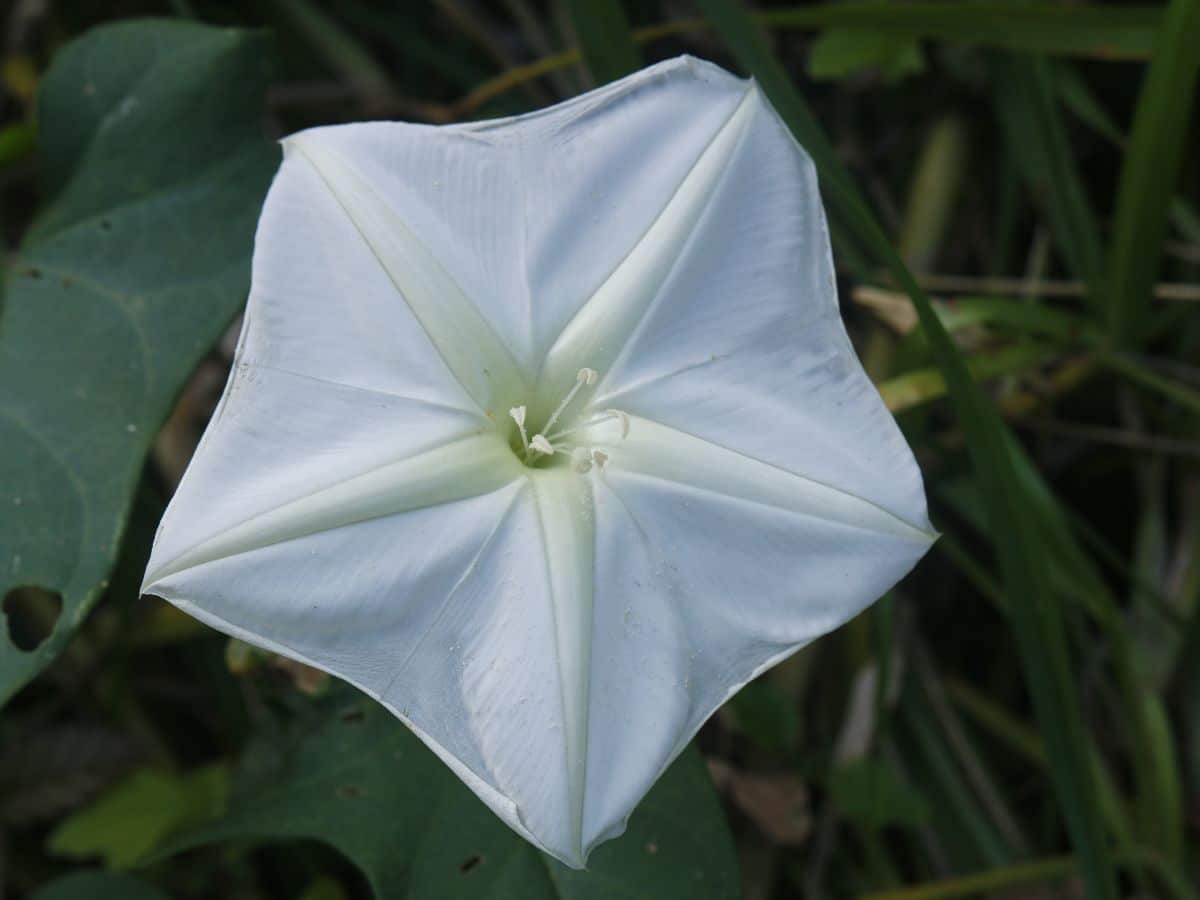
| Plant name: | Moonflower |
| Light requirements: | Full sun |
| Water requirements: | Moderate |
| Growing zone: | Zones 3 to 9 |
| Bloom time: | Late summer to early fall |
A close relative of morning glories, moonflower is a night-blooming vine that attracts nocturnal pollinators like Luna moths. These plants produce large, 5 to 8” wide flowers that are shaped much like morning glories but in a brilliant white color that shows up well after dark. A top choice for moon gardens, moonflowers readily grow from seed, and they look bewitching when planted en masse along garden fences and porch railings.
Moonflowers are technically tender perennials that are hardy in zones 10 through 12; however, they can be grown as annuals in cooler locations. Plant moonflower seeds outdoors after the danger of frost has passed, and these vigorous growers will reach about 10 to 12’ in length by the end of the season. When in bloom, moonflowers emit a powerful fragrance that can make your garden feel like a magical oasis after dark.
4. Star jasmine (Trachelospermum jasminoides)
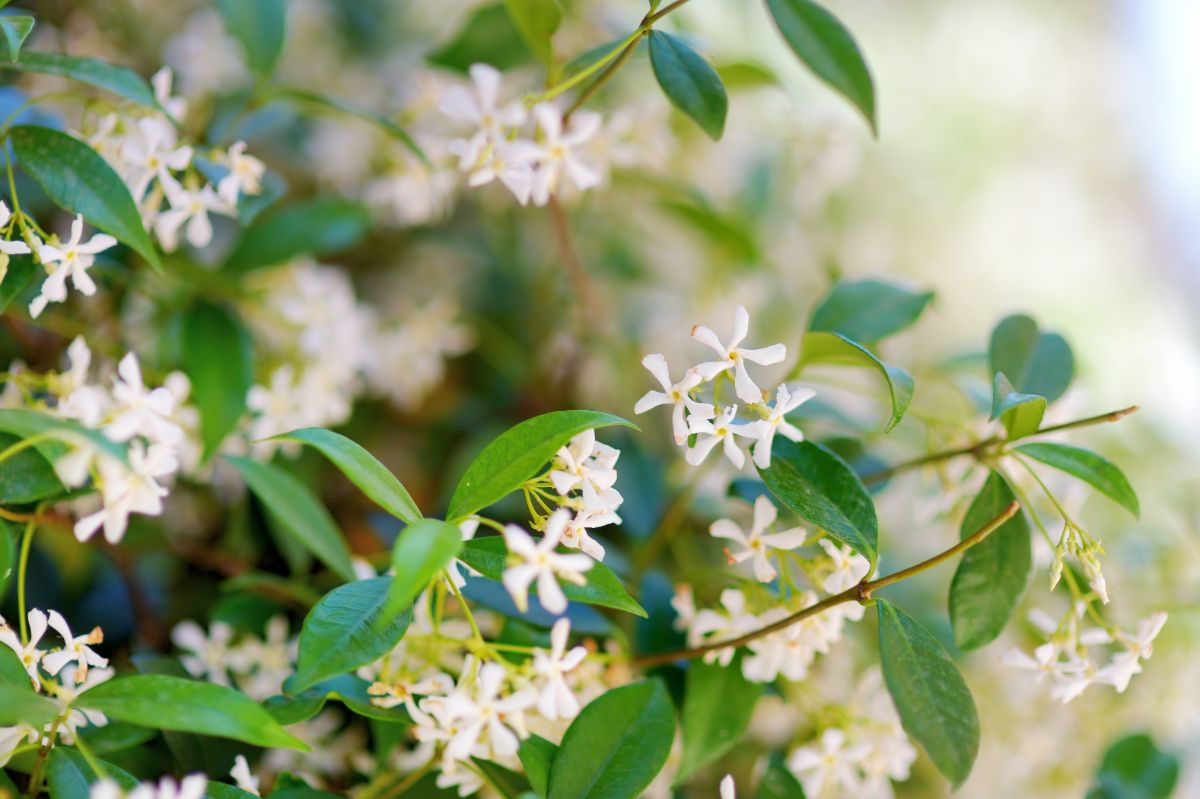
| Plant name: | Star jasmine |
| Light requirements: | Full sun to part shade |
| Water requirements: | Moderate |
| Growing zone: | Zones 8 to 10; can survive in zone 7b with winter protection |
| Bloom time: | Late spring to early summer |
Jasmine plants are well-known for their intoxicating floral fragrance, which is often used in perfume blends and other beauty care products. But if you want climbing jasmine, star jasmine is the plant for you. This fast grower can grow between 3 and 6’ per year, and the vines will eventually max out at around 20 to 30’ long.
Like most other jasmine plants, star jasmine loves warm water, but it’s not particularly cold hardy, and it only grows perennially in zones 8 through 10. In warm areas, star jasmine can occasionally become invasive, so you should be careful when growing it if you live in an area where it can overwinter. When in bloom, star jasmine is highly attractive to many beneficial insects, and you’ll find this plant’s delicate, creamy white flowers coated in bees in the summer.
5. Clematis (Clematis spp.)
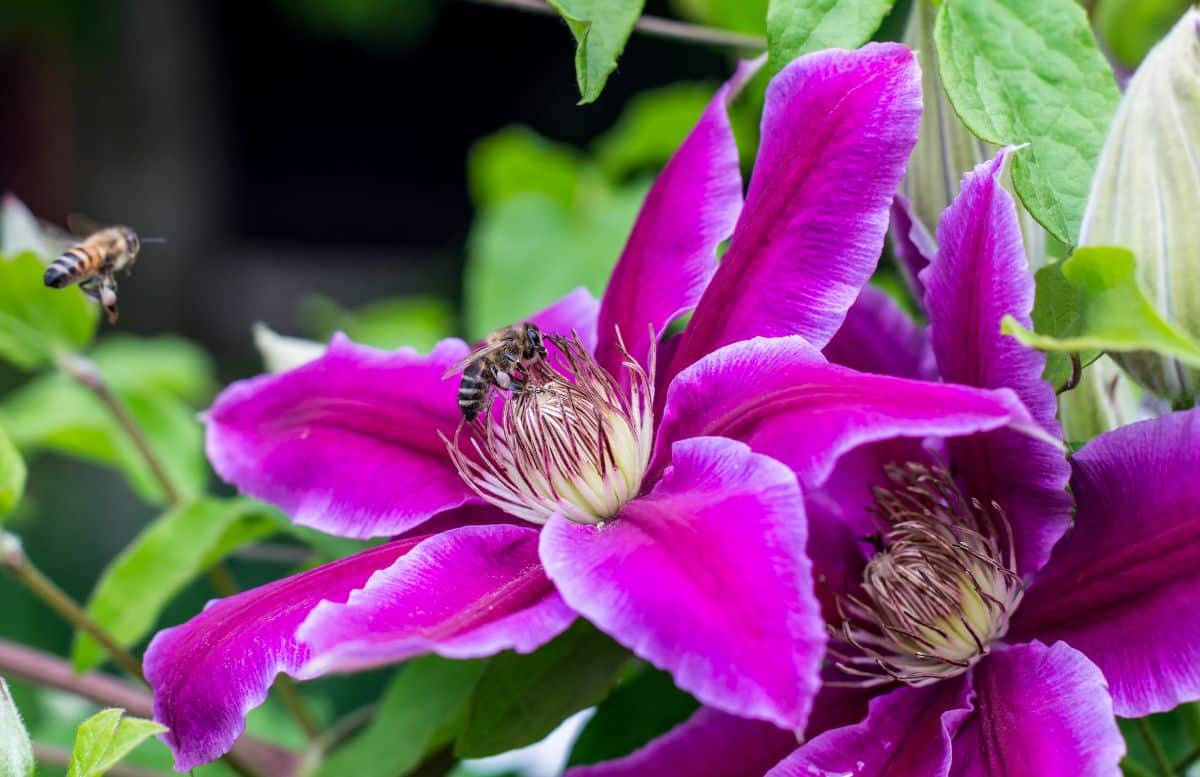
| Plant name: | Clematis |
| Light requirements: | Full sun to part shade |
| Water requirements: | Moderate |
| Growing zone: | Zones 4 to 9 |
| Bloom time: | Early to mid-summer and may bloom sporadically throughout the growing season |
Clematis are popular additions to ornamental gardens, but if your goal is to build a pollinator habitat, bees and butterflies love clematis blooms too! Clematis plants have been given many charming names over the years, including leather flower, virgin’s bower, old man’s beard, and traveler’s joy, so you may find these plants labeled differently at plant nurseries. But no matter what you call your plant, one thing clematis vines all have in common is that they bring beauty, color, and grace to any space.
There are about 380 different species of clematis, and they are closely related to buttercups. Certain clematis varieties can become invasive in some areas, but there are native varieties of clematis that aren’t such aggressive growers. Clematis are prized for their wide-open flower faces that are often bi-colored in delightful shades of pink, purple, burgundy, blue, red, and other eye-catching colors.
Tip: If you live in the United States and love growing native plants, try out the wild clematis (Clematis virginiana).
6. Chocolate vine (Akebia quinata)
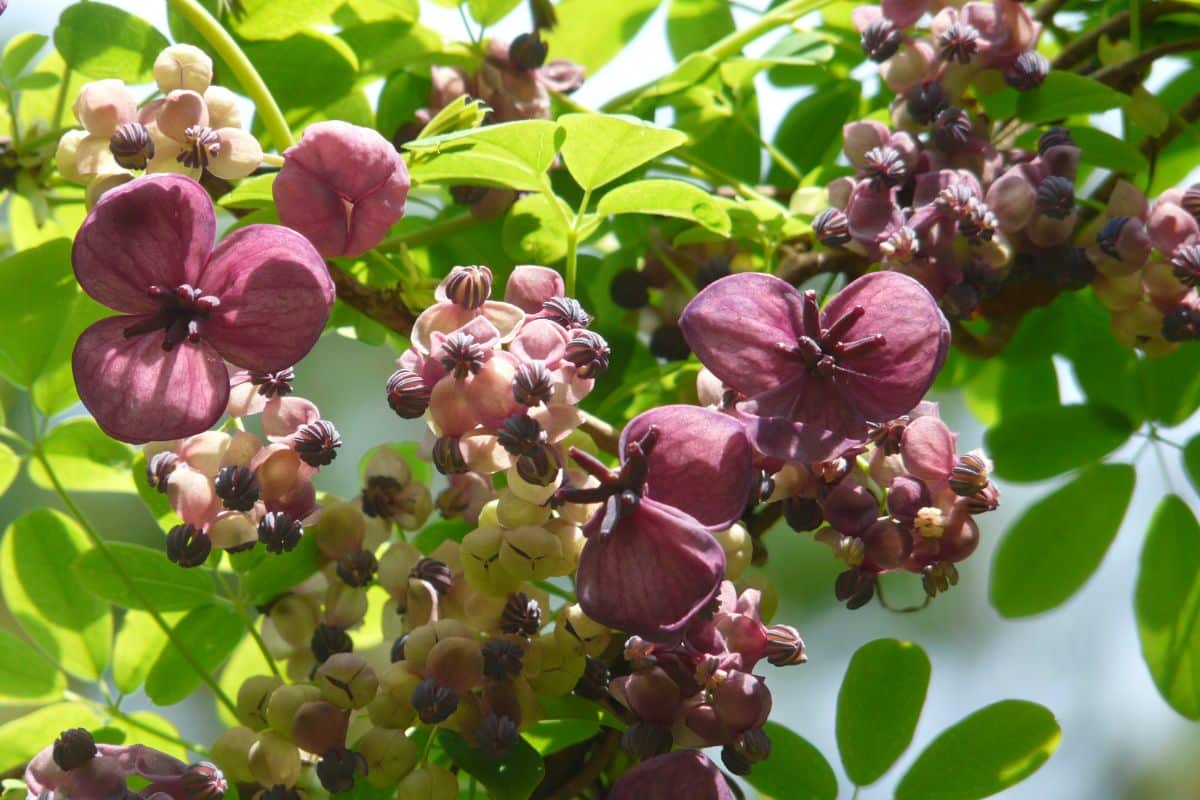
| Plant name: | Chocolate vine |
| Light requirements: | Full sun to part shade |
| Water requirements: | Moderate |
| Growing zone: | Zones 4 to 9 |
| Bloom time: | Spring |
Chocolate lovers rejoice! If you adore chocolate and gardening, the chocolate vine is a need-to-grow plant with brownish-purple flowers that emit a delicate, chocolatey aroma. Chocolate vine blooms in spring and can lure an assortment of beneficial insects to your garden, and it also makes spectacular groundcover if you don’t want to train your plant to climb.
Despite its tropical look, the chocolate vine is surprisingly cold-hardy, and it will overwinter just fine in areas as cool as Zone 4. Like many other vining plants, the chocolate vine can become invasive in some areas, so you will need to consider that if you want to grow it. While you can train the chocolate vine to grow up fences and porch railings, it is also ideal for concealing unsightly utility boxes, gutters, and more!
7. Climbing hydrangea (Hydrangea anomala)
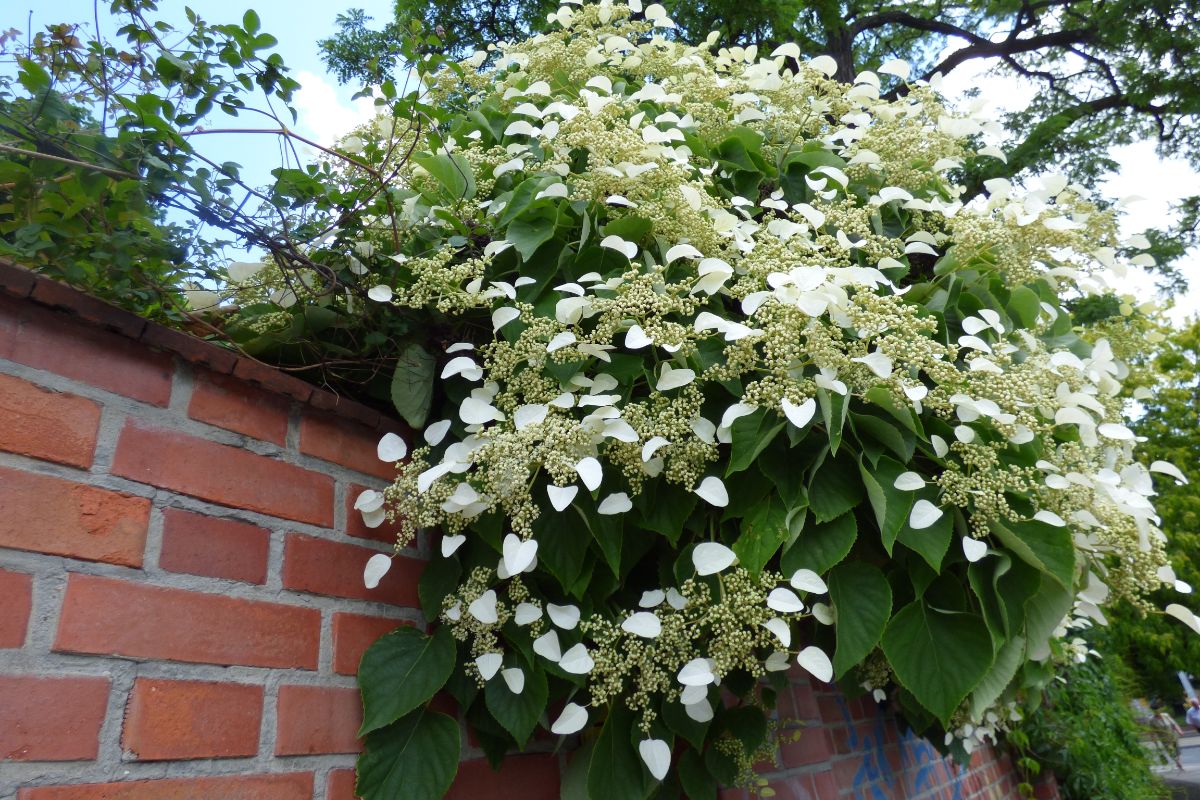
| Plant name: | Climbing hydrangea |
| Light requirements: | Full sun to shade |
| Water requirements: | High to moderate |
| Growing zone: | Zones 4 to 8 |
| Bloom time: | Late spring through late fall |
When most people think about hydrangeas, they picture large shrubs with globular flowers in brilliant shades of pink, purple, and blue. However, the hydrangea family is quite diverse, and it includes over 75 different species, including bush-type hydrangeas and vining plants too. Climbing hydrangeas are predominately mid-summer bloomers with creamy white flowers, and they also turn a bright yellow shade in autumn when their leaves change!
Climbing hydrangeas are a fantastic choice for pollinator gardens thanks to their wide-open flower faces that are rich with nectar and pollen for insects. But beyond their pollinator-friendly nature, climbing hydrangeas are also attractive plants, and their rustic charm fits in well in cottage garden designs. What’s more, while some climbing plants like English ivy can damage masonry, climbing hydrangeas have delicate root systems that won’t harm mortar!
8. Sweet peas (Lathyrus odoratus)
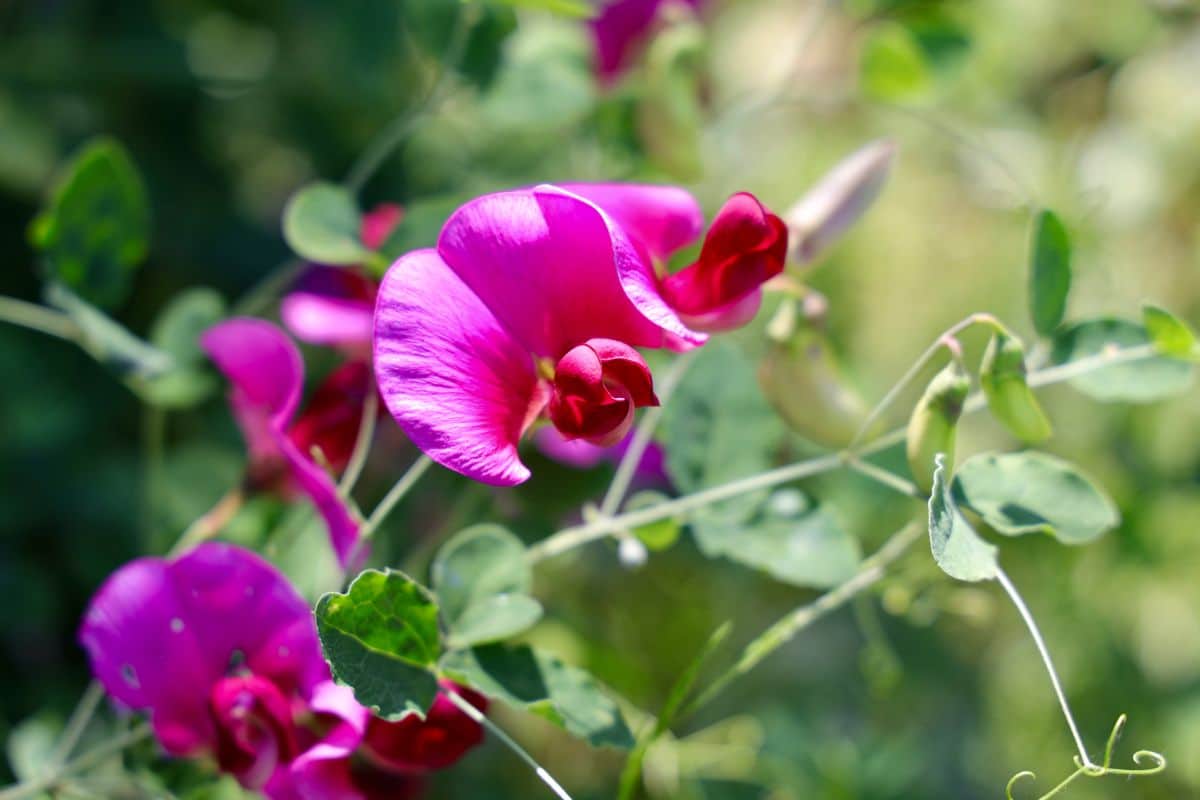
| Plant name: | Sweet peas |
| Light requirements: | Full sun to part shade |
| Water requirements: | High |
| Growing zone: | Zones 3 to 8 |
| Bloom time: | Spring and fall |
Sweet peas have an element of nostalgia to them, bringing us back to bygone days, sipping sweet tea on sunny porches and relishing the scents of a springtime garden. These climbing plants are native to the Mediterranean region and love lots of bright sun and moisture. Coming in just about every color you could want, most sweet peas have a rich fragrance with notes of honey, although newer cultivars are sometimes fragrance-free.
Despite their name, sweet peas are not edible, and they are actually toxic if ingested. But while you can’t eat these plants, you can still enjoy them in your garden or harvest them for cut flower displays and pressing. Sweet peas don’t grow well in heat, but they are staples in spring and autumn gardens and commonly grown in cottage garden designs as well as pollinator habitats!
9. Virginia creeper (Parthenocissus quinquefolia)
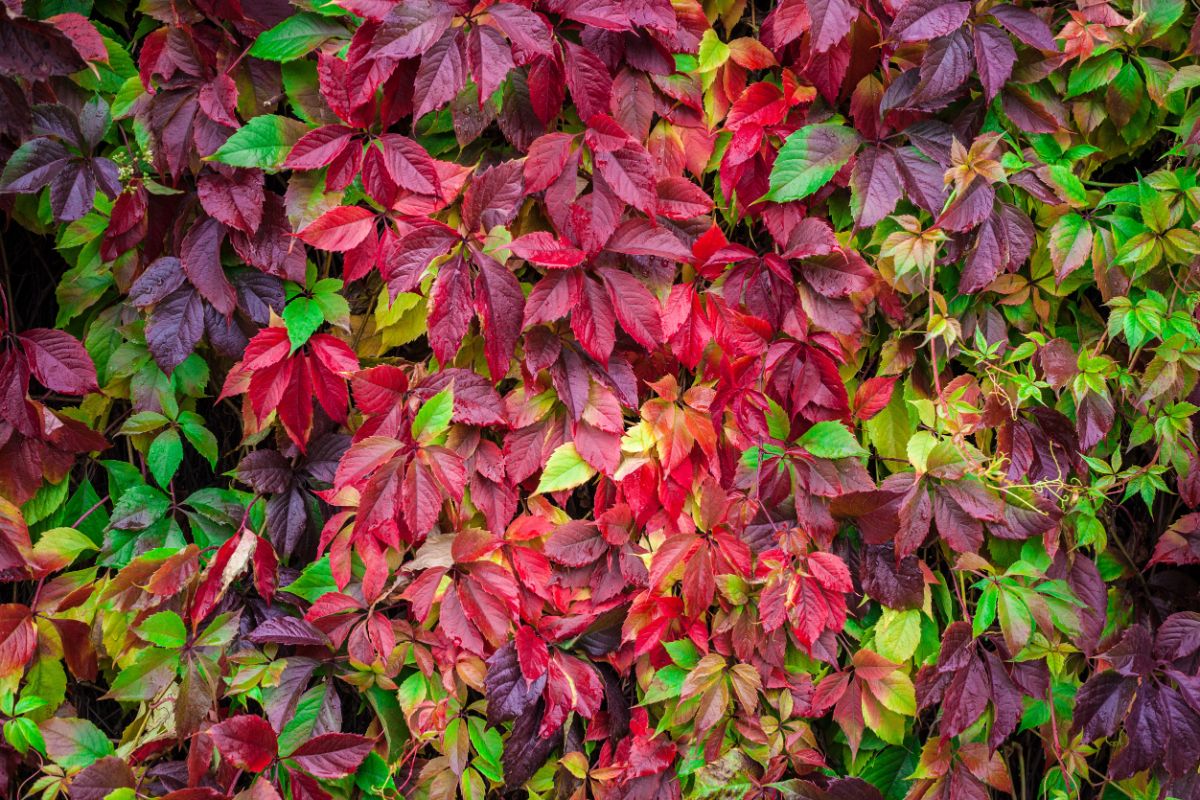
| Plant name: | Virginia creeper |
| Light requirements: | Full sun to shade |
| Water requirements: | Low |
| Growing zone: | Zones 3 to 9 |
| Bloom time: | Summer |
Virginia creeper is often confused with poison ivy, but Virginia creeper usually has 5 leaflets rather than poison ivy’s 3. Unlike poison ivy, Virginia ivy doesn’t typically cause skin reactions, but some sensitive individuals may want to wear gloves when handling this plant. Virginia creeper is a close relative of Boston ivy, and it’s particularly famous for its spectacular autumn coloration.
Virginia creeper vines can be trained to grow up mailboxes or garden walls, or you can use this easy-going plant as a low-maintenance ground cover to keep weeds at bay. These plants bloom inconspicuous flowers in summer, which pollinators love, and the Virginia creeper is also an important host plant for sphinx moths. In autumn, Virginia creeper produces showy blue berries on bright red stems, and while those berries aren’t edible for humans, birds adore them!
10. American wisteria (Wisteria frutescens)
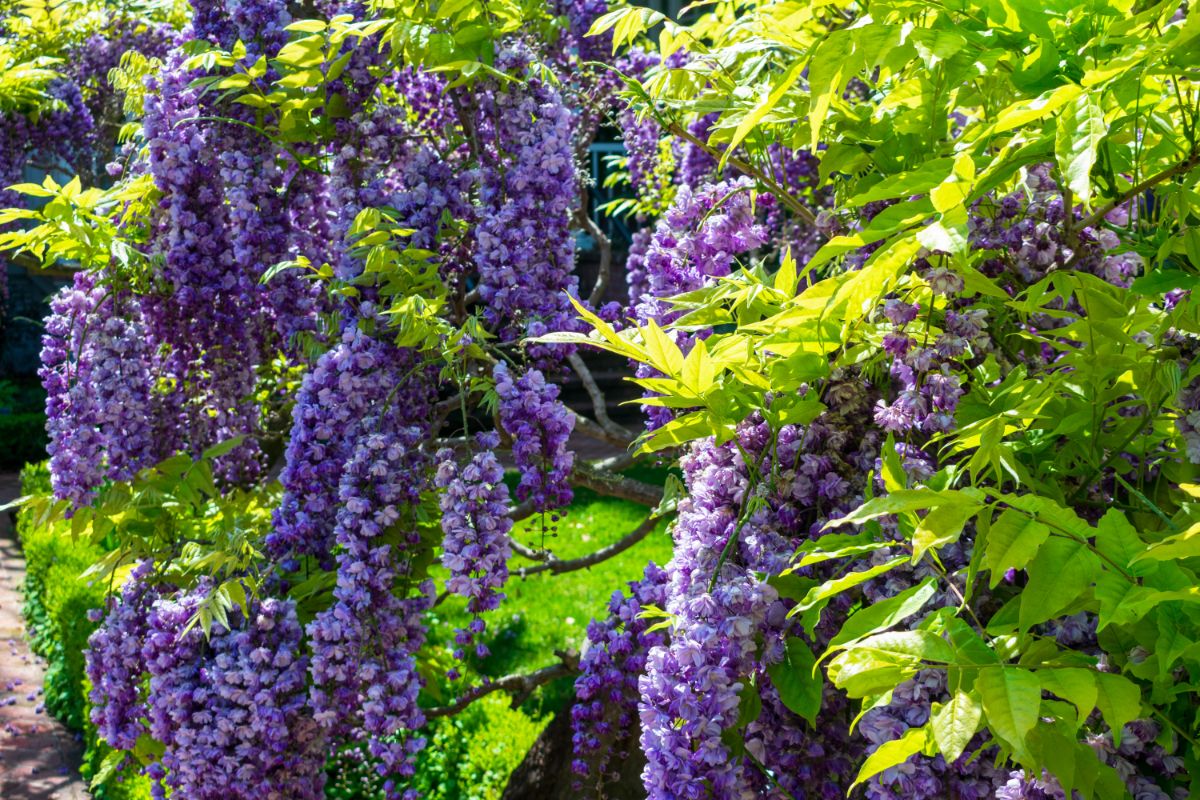
| Plant name: | Wisteria |
| Light requirements: | Full sun |
| Water requirements: | Moderate to low |
| Growing zone: | Zones 5 to 9 |
| Bloom time: | Spring |
Imported varieties of wisteria (Wisteria sinensisandWisteria floribunda) are well known for their invasive tendencies. But there are a number of different species of wisteria that don’t grow as aggressively, and one good example is the American wisteria. While this plant still grows vigorously, it’s less likely to cause problems in your garden, and, as a native plant, it’s especially well suited to the needs of native pollinators.
American wisteria has the same gorgeous purple blooms as other wisteria varieties, although the flowers are a bit smaller. When flowers emerge in spring, they’re inundated with an assortment of beneficial insects, and birds often use wisteria vines for nest building too. Mature American wisteria vines can grow up to 30’ long, so make sure you grow them on a study arbor or other support system!
11. Scarlet runner beans (Phaseolus coccineus)
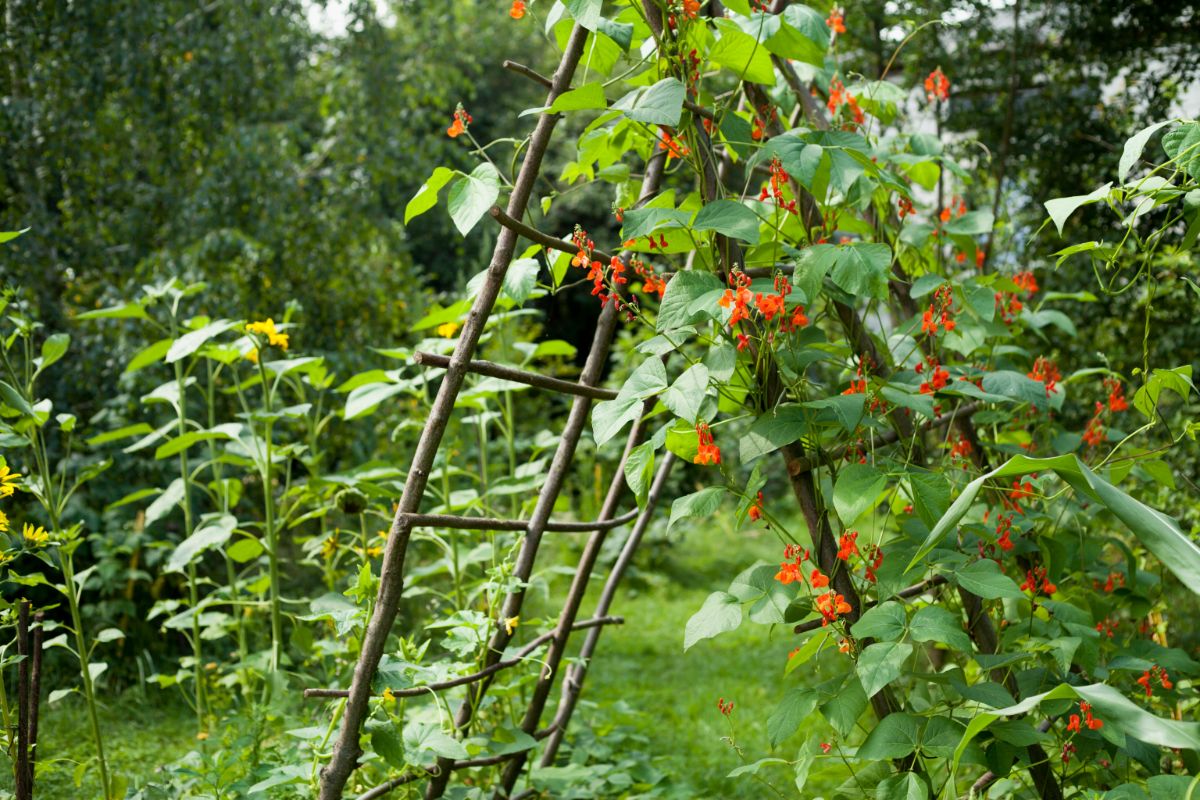
| Plant name: | Scarlet runner beans |
| Light requirements: | Full sun |
| Water requirements: | High to moderate |
| Growing zone: | Zones 7 to 11, grown as an annual in cooler areas |
| Bloom time: | Mid-summer to fall |
Beans are mostly grown for their edible pods, but Scarlet runner beans aren’t just edible. These vining annuals sprout scarlet red flowers throughout the summer months, and they’ll attract a variety of pollinators to your vegetable garden. If you’ve struggled with vegetables not being pollinated, companion planting with scarlet runner beans can be an easy way to boost the yield of your garden.
Although scarlet runner beans are prized as ornamentals, their pods are tasty too. There’s some debate about whether or not scarlet runner beans are good for fresh eating, but they are perfect for steaming, and they can be cooked just like edamame. Scarlet runner beans can also be dried for winter preservation!
12. Passionflower (Passiflora incarnata)

| Plant name: | Passionflower |
| Light requirements: | Full sun |
| Water requirements: | Moderate |
| Growing zone: | Zones 6 to 10 |
| Bloom time: | Mid-summer to fall |
Passionflower has a very tropical look, but surprisingly these plants are native to North and South America, and they can grow perennially in zones 7 to 10. In cooler locations, passionflower can be grown in pots with trellising or kept in hanging baskets and overwintered indoors.
There are many different types of passionflowers, including some that grow as shrubs, but the vining varieties of passionflowers tend to be easiest to find at nurseries, and you can also grow them from seed. Most passionflower vines produce edible fruit, and the flesh of passionfruit is said to be some of the most intensely flavored fruit you can find. Before fruiting, passionflower vines bloom distinct, purple flowers that only last a day or so, but pollinators find them anyway!
13. Butterfly vine (Mascagnia macroptera)
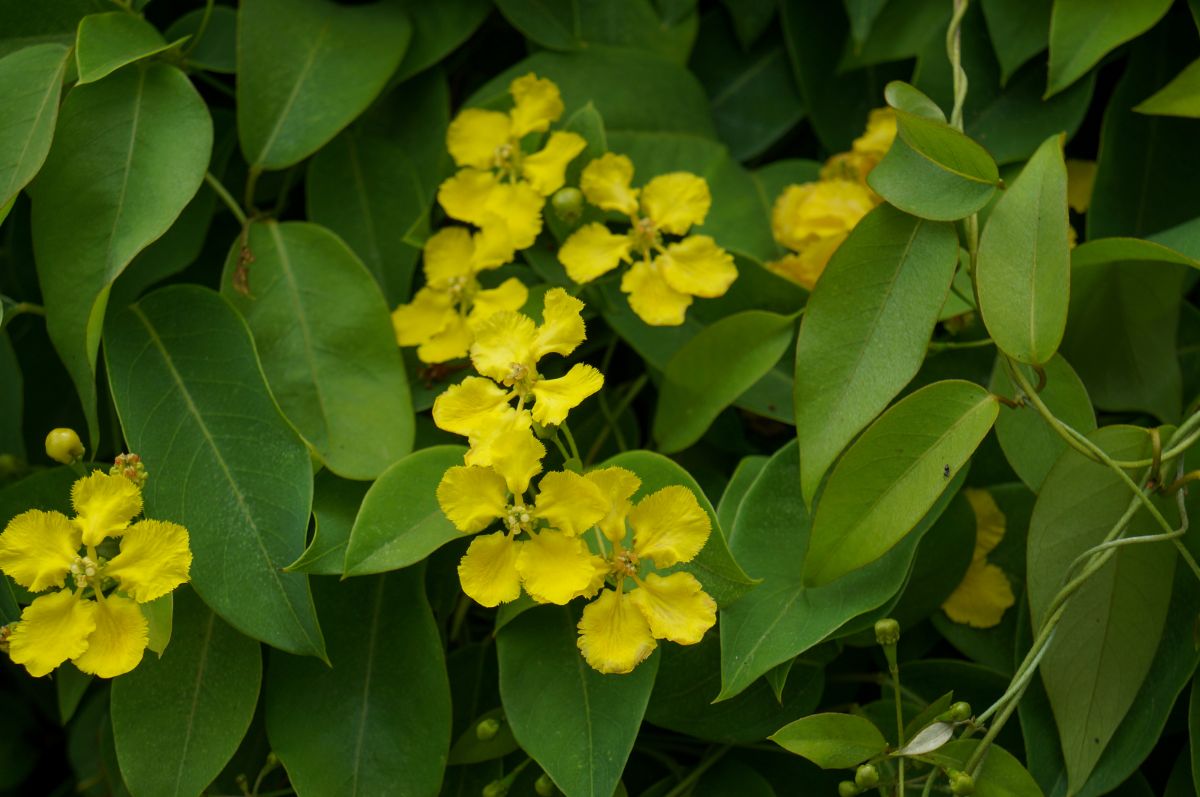
| Plant name: | Butterfly vine |
| Light requirements: | Full sun to part shade |
| Water requirements: | Low |
| Growing zone: | Zones 8 to 10; can survive in zone 7 with winter protection |
| Bloom time: | Spring to fall |
Native to Central America, the butterfly vine is another top pollinator plant, although it’s only hardy in zones 8 and up. In warm areas, the butterfly vine grows as an evergreen, but it’s mostly known for its spring-blooming flowers that are a bright, sunny yellow and shaped a bit like orchids.
In gardens, butterfly vines will attract an assortment of butterflies, as well as other beneficial insects. If you’re lucky, you may get a second flush of flowers off your vine in autumn, but these plants also provide year-round privacy, which is always a plus!
14. Bougainvillea (Bougainvillea spp.)
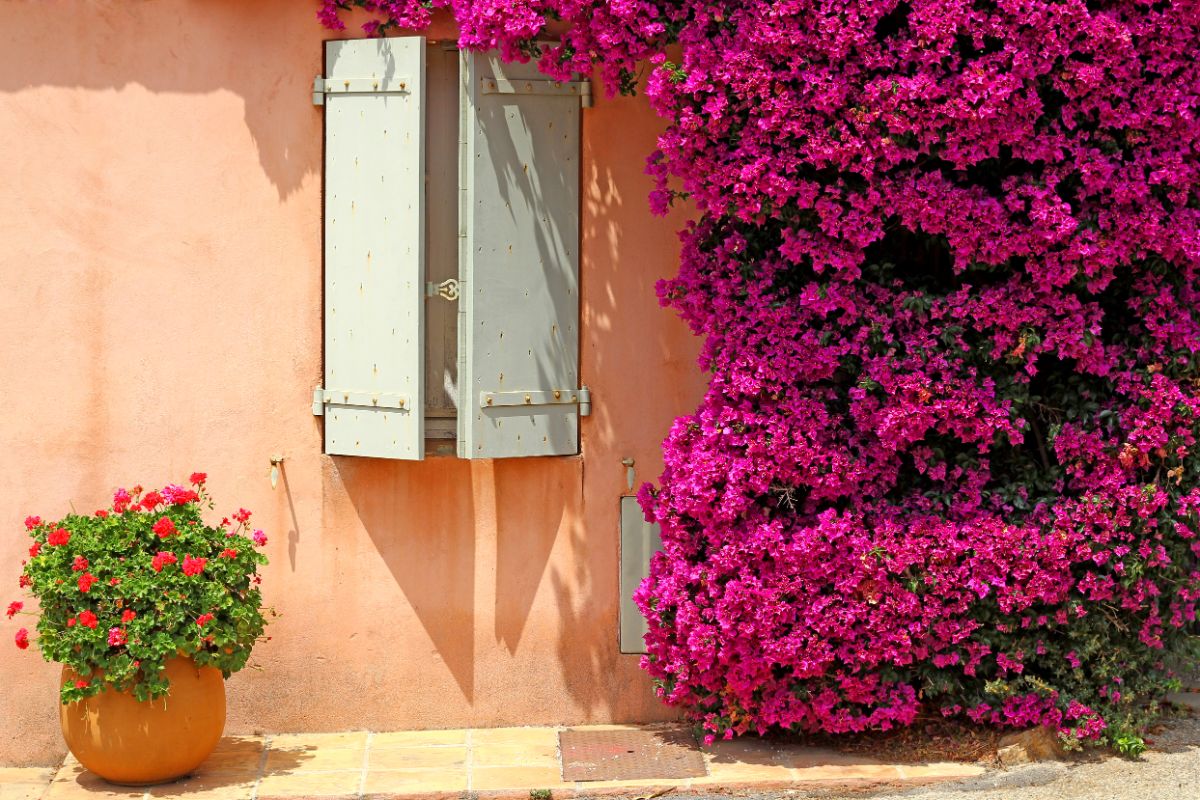
| Plant name: | Bougainvillea |
| Light requirements: | Full sun |
| Water requirements: | Low |
| Growing zone: | Zones 9 to 11 |
| Bloom time: | Spring to fall |
Another heat-loving plant, bougainvillea, is native to areas of South America where the summers are hot and long. A spectacular bloomer, bougainvillea can also be grown in other areas, but it’s only hardy to zone 10 (or perhaps 9 with winter protection). If left unchecked, bougainvillea can sometimes become invasive in warm spots, so it’s best to plant it on an arbor or fence railing to make it easier to manage.
Also known as the paper flower, bougainvillea has thin, papery bracts that come in a variety of colors, including white, pink, and red. When properly maintained, these plants stay green all year round, and they can grow up to 30’ long when mature. As far as pollinators go, butterflies, bees, and nocturnal moths are some of the most common insects to visit bougainvillea vines.
15. Squash, melons, and cucumbers (Cucurbita spp.)

| Plant name: | Squash, melons and cucumbers |
| Light requirements: | Full sun |
| Water requirements: | Moderate |
| Growing zone: | Zones 3 and up |
| Bloom time: | Summer |
If you want to lure pollinators to your garden with vining plants but you prefer edible gardening, you can grow squash, melons, cucumbers, and other members of the Cucurbit family instead. These vining plants are often grown on solid ground, but you can train them to grow up trellises or garden archways to save soil space and add vertical interest to your beds. In general, Cucurbits with smaller fruit are best for trellises, but you can also train plants with large fruit to climb if you support their fruit with nylon stockings or fruit cradles.
Most Cucurbit plants flower in summer and need the help of pollinators to produce their edible cucumbers, melons, and squash. Bees and other beneficial insects love foraging in the nectar and pollen-rich flowers, and you’ll reap the rewards of their work with an abundant harvest. For even more ornamental appeal, try out striking cultivars like the ‘Trombonino Squash’ or birdhouse gourds.
Tip: If you love native plants, try growing wild cucumber (Echinocystis lobata). This easygoing plant is native to North America, and pollinators adore it too!
16. Grapes (Vitis spp.)
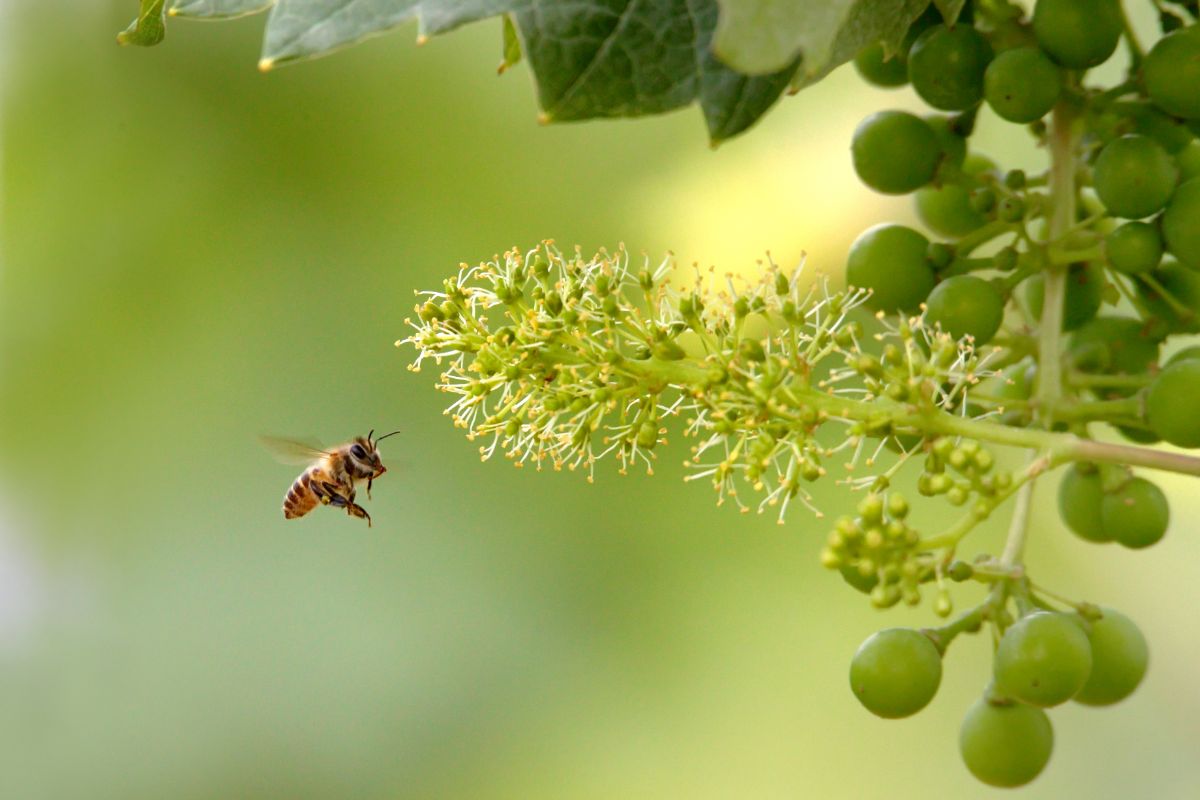
| Plant name: | Grapes |
| Light requirements: | Full sun |
| Water requirements: | Moderate |
| Growing zone: | Zones 4 to 10 |
| Bloom time: | Late spring |
Fancy growing more edible plants that will be equally delicious for you and pollinators? Then why not plant some grape vines!
Early in the season, bees and other pollinators sup on the nectar and pollen in grape flowers. Later on, insects return to lap up the sweet juice of overly ripe grapes that fall on the ground in late summer to fall. However, if you don’t want to deal with bees and wasps on your grape clusters, you can always wrap up your grapes with fruit protection bags!
Tip: For a native plant option, try out the wild grape (Vitis labrusca or Vitis riparia)!
17. Crossvine (Bignonia capreolata)
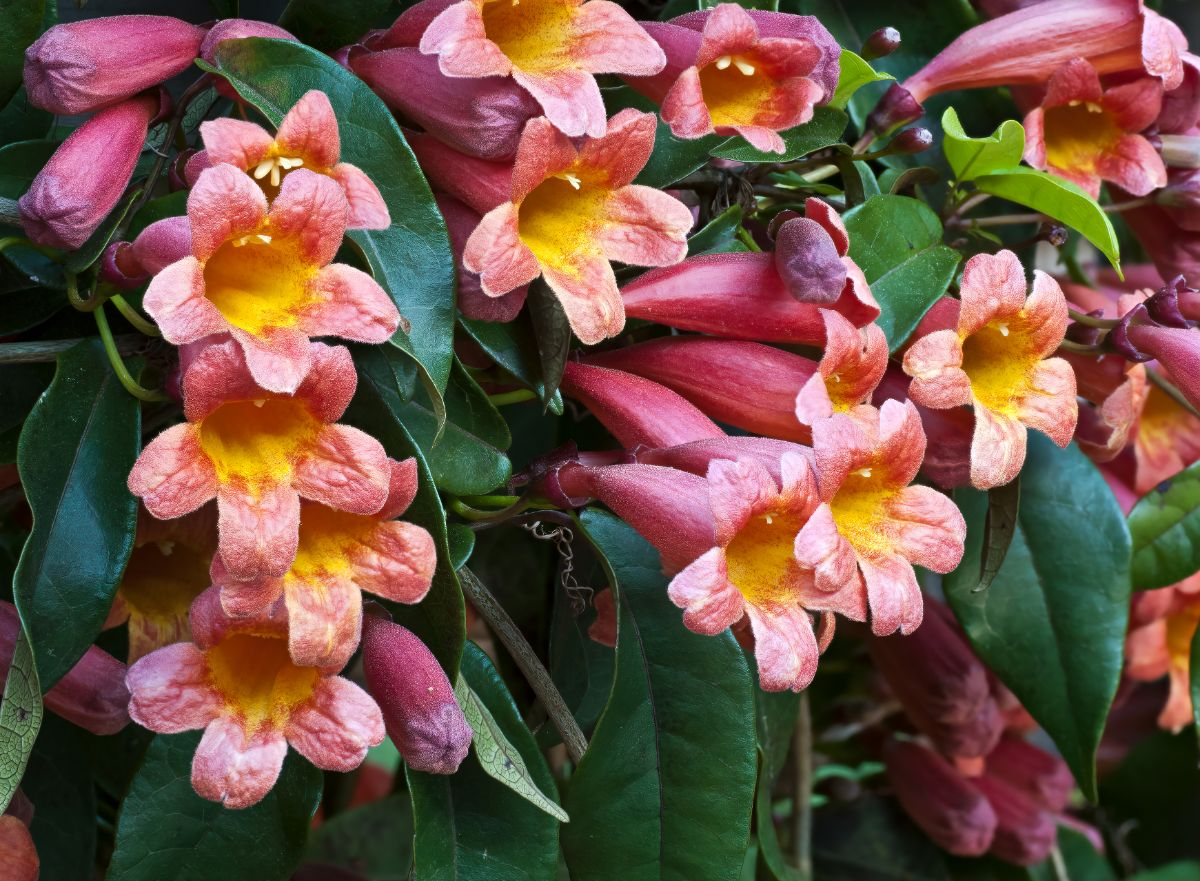
| Plant name: | Crossvine |
| Light requirements: | Full sun to part shade |
| Water requirements: | Low |
| Growing zone: | Zones 6 to 9 |
| Bloom time: | Mid-spring to late summer |
If you’re worried about the potential for invasiveness in trumpet vines, crossvine is a great alternative. This pollinator plant is native to the eastern United States, and it has large, trumpet-shaped flowers that are a vivid reddish-orange tone, often with yellow accents.
Mature plants can grow up to 50’ long, but they aren’t aggressive growers like trumpet vines can be. Crossvine flowers are rich with sweet nectar, and their bright coloration is easy for ruby-throated hummingbirds and other pollinators to spot from a distance.
18. Dutchman’s Pipe (Aristolochiamacrophylla)
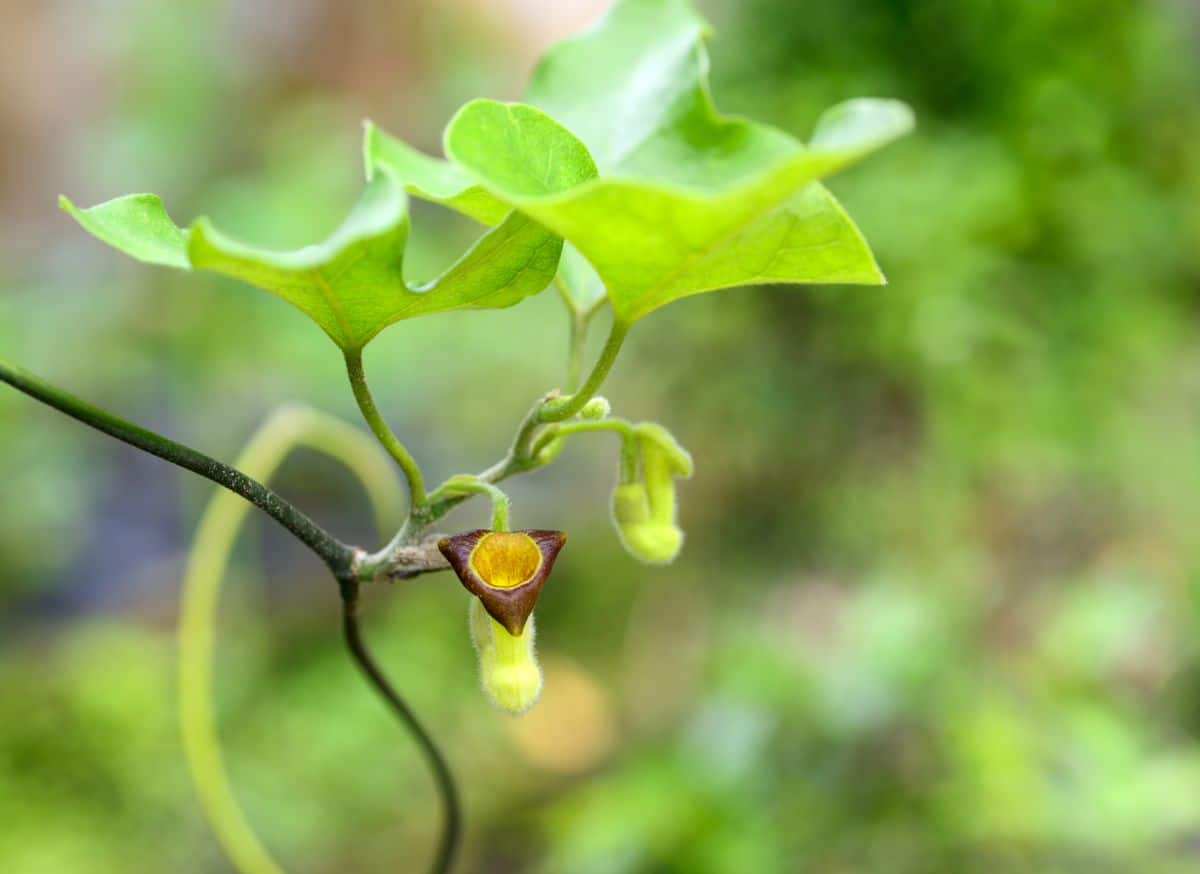
| Plant name: | Dutchman’s pipe |
| Light requirements: | Full sun to shade |
| Water requirements: | Moderate |
| Growing zone: | Zones 4 to 8 |
| Bloom time: | Mid-spring to early summer |
Dutchman’s pipe grows in the wild throughout eastern North America, but it has also been cultivated as an ornamental since at least the Victorian era. This vining plant is mostly grown for its dense foliage, which can be used as a natural privacy screen around porches and patios. However, it also produces curious, pipe-shaped flowers that attract flies and other pollinators.
Like many other native plants, Dutchman’s pipe is an adaptable species that are super easy to care for. These plants can grow in full sun or part shade, and they enjoy regular watering. Just keep in mind that you should always direct your hose toward the base of the plant when watering, as Dutchman’s pipe is prone to mildew issues when its leaves get wet.
Summary

The best pollinator habitats feature an assortment of plants in different colors, flower shapes, and bloom times to suit the needs of different pollinators. But once you’ve filled up your beds with perennials and annuals, growing vining plants for pollinators can entice even more wildlife to visit your garden. Full of nectar and pollen that insects need, pollinator vines also provide habitat for pollinators, extra privacy for you, and even more color and beauty to your garden.
For more pollinator gardening tips, see our guides on the best plants for bees, butterflies, and hummingbirds!

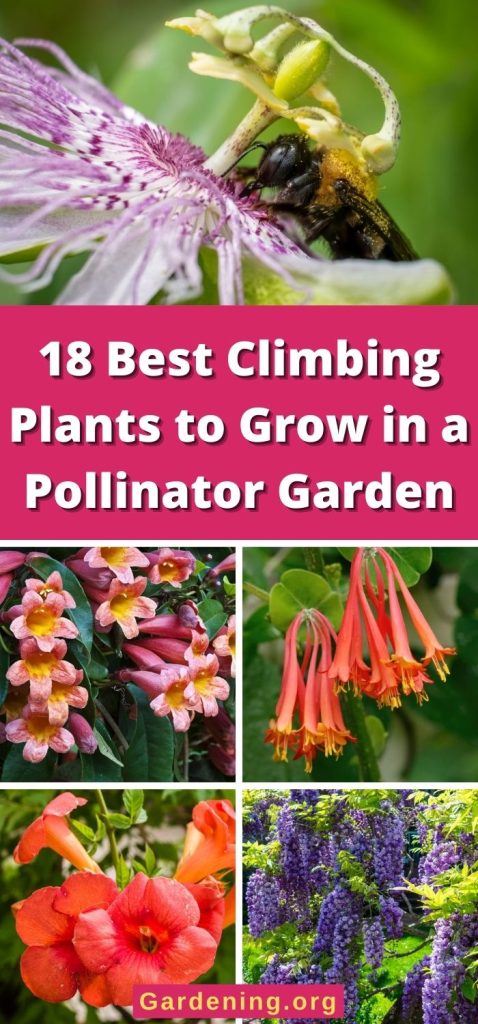
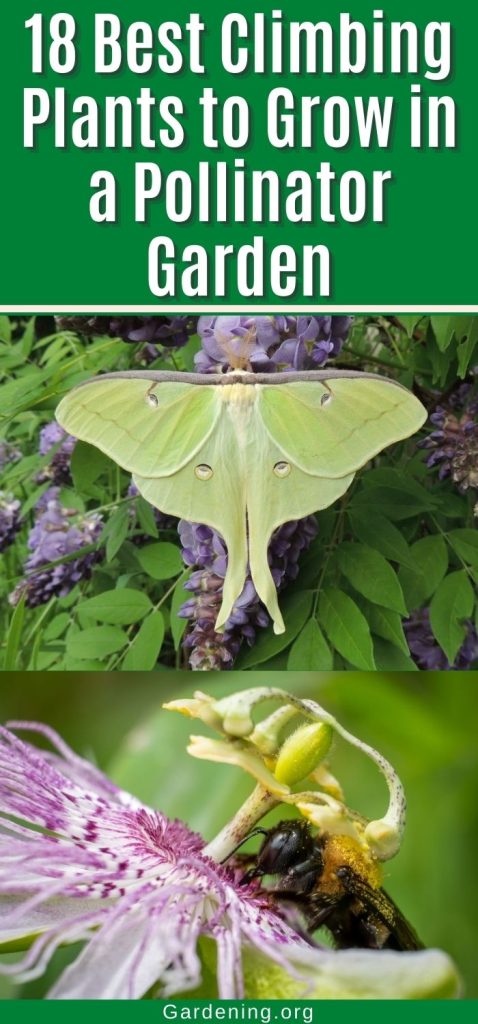
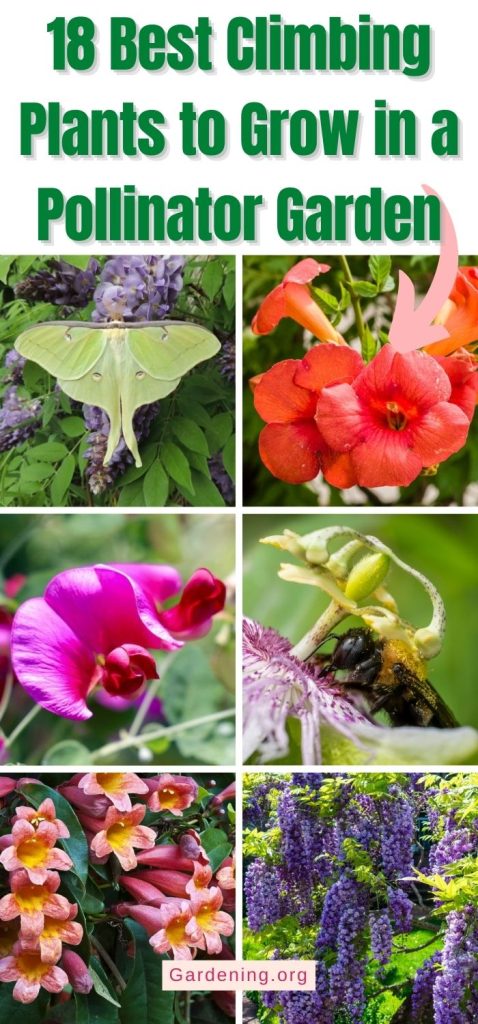


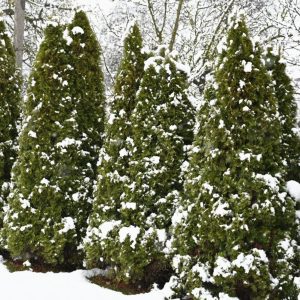


Leave a Reply